Fundamental Skills of Sports – Volleyball Chapter Notes | Physical Education for Grade 6 PDF Download
| Table of contents |

|
| Introduction |

|
| Underhand Pass |

|
| Overhead Pass |

|
| Underhand Serve |

|
| Overhand Serve |

|
| Setting |

|
| Spike |

|
| Block |

|
| Dig |

|
| Ball Rotation Activity |

|
| Ace Accuracy Contest |

|
| Ball Throw Activity |

|
| 11-Point Match |

|
Introduction
Volleyball is a fast-paced and exciting team sport played between two teams on a rectangular court divided by a net. The main goal is to score points by sending the ball over the net so that it lands inside the opponent’s court. Each team has six players, and every player has specific roles like spiker, setter, blocker, or libero. A team is allowed a maximum of three touches to return the ball, and the block does not count as one of those touches. This chapter teaches the basic fundamental skills of volleyball such as serving, passing, setting, spiking, blocking, and digging.
Underhand Pass
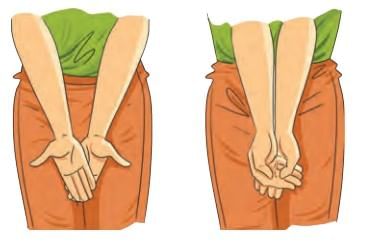 The underhand pass is also called a bump pass, dig pass, or simple pass. It is used to receive and control the ball, usually after a serve or an attacking hit like a smash or spike.
The underhand pass is also called a bump pass, dig pass, or simple pass. It is used to receive and control the ball, usually after a serve or an attacking hit like a smash or spike.
1. Grip and Hand Position
- Join hands by overlapping one over the other.
- Form a semi-closed fist with one hand and cover it with the other.
- Keep thumbs parallel, pointing forward and slightly down.
- Elbows must remain locked and straight, arms extended in front, and wrists bent downwards.
2. Stance
- Feet should be shoulder-width apart and placed diagonally.
- Knees slightly bent, spine straight, and lean a little forward.
- Keep arms relaxed but ready below the chest.
- Maintain a low stance for balance and better control.
3. Execution
- Move your body under the ball’s path.
- Let the forearms contact the ball with locked elbows.
- Swing arms upwards while extending knees to lift the ball.
- Push the ball higher using the forearms and extended knees.
4. Follow-through
- Keep arms stable after contact.
- Direct the ball towards the intended direction.
- Avoid unnecessary arm motion to maintain accuracy.
Note: Always call out “Mine!” loudly to alert teammates when going for the ball.
Overhead Pass
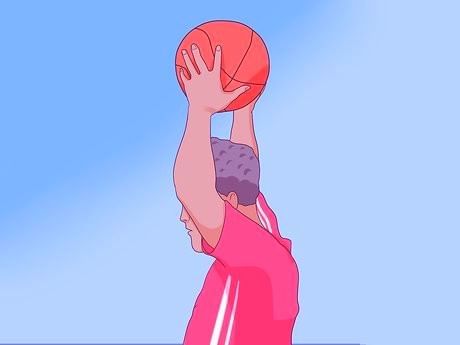 The overhead pass is used for setting the ball or receiving it when it comes at face level.
The overhead pass is used for setting the ball or receiving it when it comes at face level.
1. Hand Position and Ball Contact
- Hands kept above the forehead with thumb and index fingers forming a triangle.
- Ball should touch the fingertips, not the palms.
2. Body Position
- Feet shoulder-width apart, one foot slightly forward.
- Knees bent, torso under the ball.
- Elbows slightly bent and outwards to form a cup-shaped platform.
3. Execution
- Move quickly to position under the ball (above hairline or midline).
- Stay balanced and face the target direction.
- Contact the ball above hairline and push it upwards using palms.
- Straighten legs to add force and accuracy.
4. Follow-through
- Arms extend fully towards the target.
- End with hands pointing in the direction of the ball.
- Stay balanced and ready for the next move.
Underhand Serve
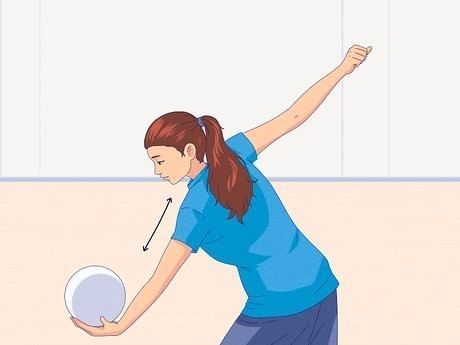 In this serve, the ball is struck using an upward-forward swinging motion with the arm moving like a pendulum.
In this serve, the ball is struck using an upward-forward swinging motion with the arm moving like a pendulum.
1. Stance
- Non-dominant foot slightly forward, toes pointing straight.
- Hold the ball with the non-dominant hand, slightly cupped.
- Knees bent, body balanced, and shoulders directed towards the ball.
- The ball should be held near the thigh of the hitting arm.
2. Execution
- Swing the serving arm in a pendulum style and strike the bottom of the ball with a closed fist.
- Shift body weight to the front foot while hitting.
3. Follow-through
- After striking, the arm continues moving upward in an arc.
- Body moves forward and upward to send the ball across the net.
- Arm should reach maximum height for proper flight.
Overhand Serve
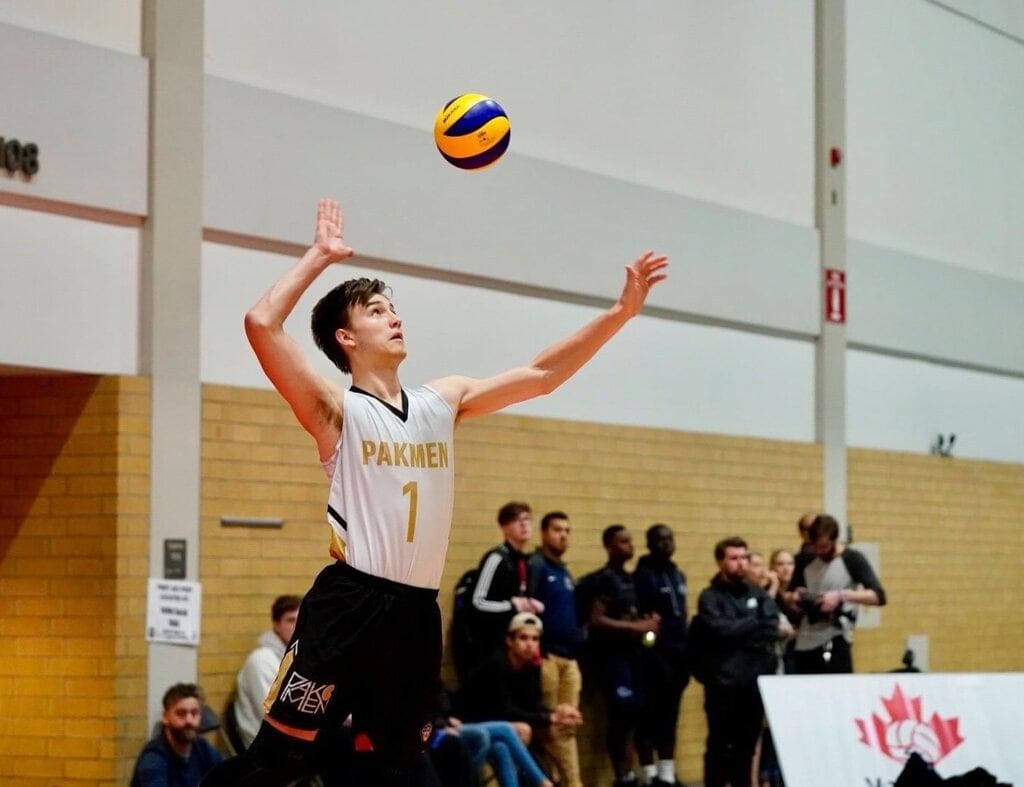 Here, the ball is tossed upward and hit with an overhead arm swing.
Here, the ball is tossed upward and hit with an overhead arm swing.
1. Stance
- Stand behind the baseline, feet shoulder-width apart.
- Place the foot opposite the hitting arm slightly forward.
2. Execution
- Toss the ball vertically using the non-dominant hand.
- Step forward with the opposite foot of the hitting hand.
- Swing the hitting arm back, then bring it forward leading with the elbow.
- Hit the ball using the heel or base of the palm.
3. Follow-through
- Transfer body weight from back foot to front foot.
- After contact, allow the hand to drop naturally near the thigh.
Setting
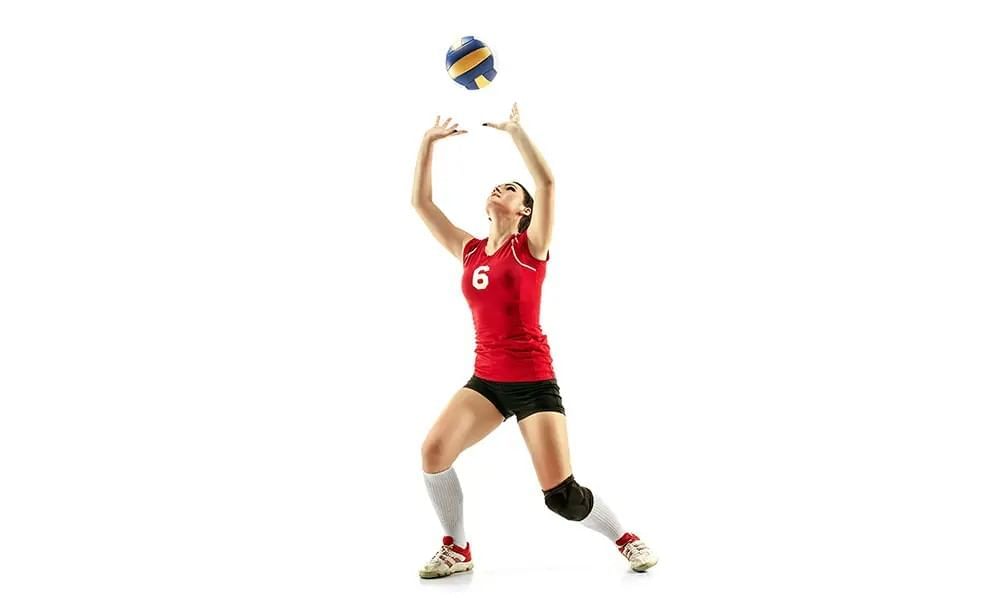 Setting is preparing the ball for a spiker to attack effectively. It is also called boosting.
Setting is preparing the ball for a spiker to attack effectively. It is also called boosting.
1. Stance
- Watch the ball carefully while preparing.
- Bend elbows slightly, position them outward near forehead to form a cup-shaped platform.
- Ensure the toss is placed near the net for the spiker’s ease.
2. Execution
- Depending on the ball’s fall, use an overhand pass to set it high or low.
- Set the ball forward or backward near the net.
3. Follow-through
- Extend arms in the direction of the ball.
- Complete the action smoothly and accurately.
Spike
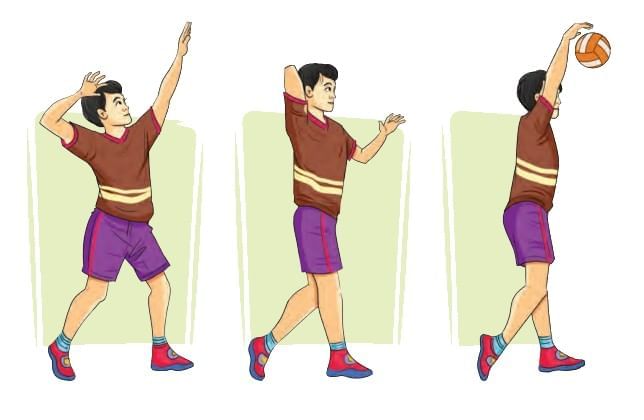 Spiking is forcefully hitting the ball over the net towards the opponent’s court. It is also called a smash.
Spiking is forcefully hitting the ball over the net towards the opponent’s court. It is also called a smash.
1. Stance
- Stand balanced with feet shoulder-width apart under or behind the ball.
- Raise the dominant arm with elbow bent behind head for power.
- Watch the ball continuously.
2. Execution
- Extend non-dominant hand upward while aligning body with the falling ball.
- Swing dominant arm down forcefully and hit ball at its highest point with the palm.
- Snap wrist to create spin and downward trajectory.
- Rotate torso slightly to add power from the core.
- Right-handed players step left-right-left; left-handed players reverse this.
3. Follow-through
- After contact, arm continues forward and downward.
- Wrist snaps to guide ball across court.
Block
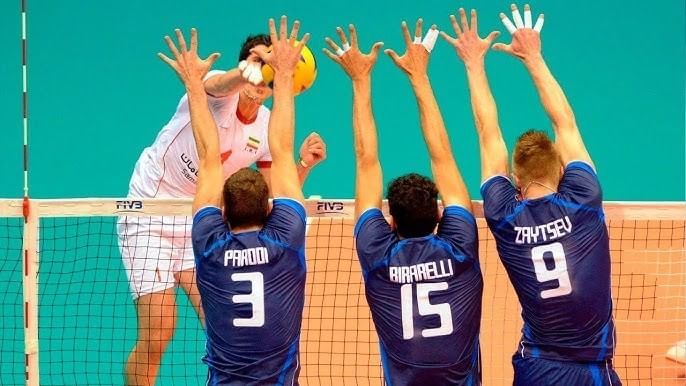 Blocking is a defensive move to stop or deflect the opponent’s spike at the net.
Blocking is a defensive move to stop or deflect the opponent’s spike at the net.
1. Stance
Stand close to the net, knees bent, arms raised, on toes, ready to move.
2. Execution
- Jump and extend hands above the net in front of spiker.
- Spread fingers and angle hands downward to direct ball back.
3. Follow-through (Landing)
Land with bent knees to absorb impact and quickly prepare for next move.
Dig
 Digging is a defensive skill to stop the ball from touching the ground after an opponent’s spike.
Digging is a defensive skill to stop the ball from touching the ground after an opponent’s spike.
1. Stance
- Feet shoulder-width apart, knees bent, body low.
- Weight on toes for quick movement.
- Arms extended with hands joined, making a strong platform.
- Stay low and ready for reaction.
2. Execution
- Move quickly under the ball.
- Keep arms straight, contact ball with forearms.
- Angle arms to direct ball to setter.
- Preferably use both hands together for control.
- Absorb ball impact using legs, not swinging arms.
3. Follow-through
- Maintain control and balance after ball contact.
- If diving, roll to absorb impact.
Ball Rotation Activity
Players are divided into three groups: Blocker, Spiker, Setter. One player from each group performs their skill in sequence: setter sets → spiker spikes → blocker blocks.
Ace Accuracy Contest
- Players serve one by one from the serving line.
- If the ball lands in a target area, extra points are awarded.
- Team with maximum points wins.
Ball Throw Activity
- Game played with 6 players in each team.
- One team serves underhand/overhand, the other catches and must throw back within 3 seconds.
- Players cannot move positions while throwing.
- After winning a serve, team rotates one position clockwise.
- The first team to reach 11 points wins.
11-Point Match
- Teams of 6 players each.
- Match is played up to 11 points.
- Winning team plays the next round.
|
16 docs|4 tests
|
FAQs on Fundamental Skills of Sports – Volleyball Chapter Notes - Physical Education for Grade 6
| 1. What is the purpose of the underhand pass in volleyball? |  |
| 2. How does the overhead pass differ from the underhand pass? |  |
| 3. What techniques should be used for an effective underhand serve in volleyball? |  |
| 4. What is the role of a setter in volleyball? |  |
| 5. Why is the dig an important skill in volleyball? |  |














